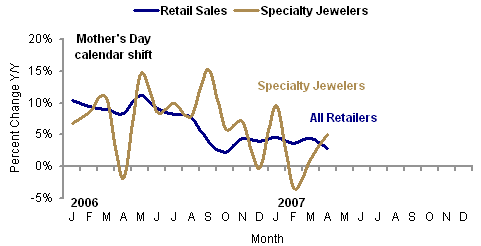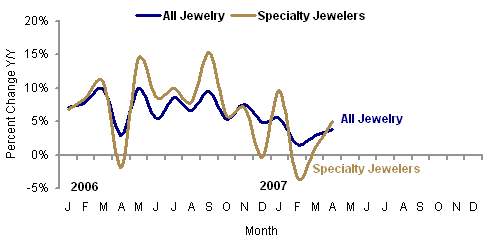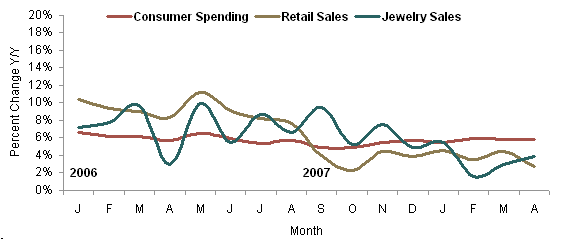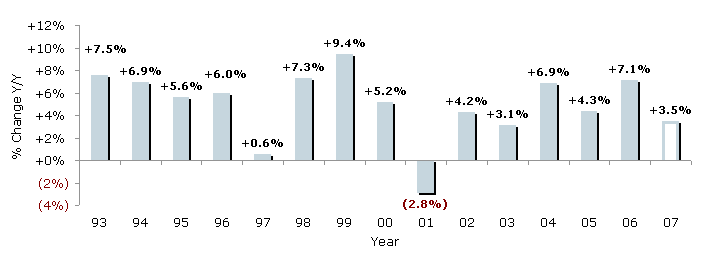IDEX Online Research: U.S. Specialty Jewelers’ Sales Up Solidly in April
June 17, 07
U.S. jewelers have been complaining about soft sales this spring, but the Department of Commerce would argue that they might be wrong. In the month of April, specialty jewelers’ sales rose by 5.0 percent versus the same month a year ago. This was the strongest month since January.
Likewise, consumers’ spending on jewelry at all merchants (specialty jewelers, discounters, mass market retailers, etc.) was also up by 3.9 percent in April, the largest gain since January.
But before we start cheering, an analysis of last year’s results shows that comparisons to April 2006 were easy, since that was the weakest month of the prior year.
Numbers aside, demand for jewelry has been soft since before the Valentine’s Day selling period and it remains soft.
While jewelry sales for May have not yet been reported, we expect weak numbers, based on preliminary sales reports for Mothers Day from a small sample of jewelers as well as sales reports from other merchants.
The graph below summarizes U.S. jewelry sales through April as compared to total retail sales trends.
| U.S. Jewelry Sales Trends |
Overall Retail Sales Trends Weaken
Gasoline sales are showing the largest growth of any retail category, as expected. Gasoline prices began their climb in April, and continued into May, before a pause in mid-June. Unit sales (gallons) remained steady, so consumer spending at the pump rose sharply. Unfortunately, that’s about the only retail category showing any notable growth.
Most retailers are reporting that demand for consumer durables – furniture, jewelry, and other durable goods – has been weakening all during the Spring selling season.
Overall, consumer demand for goods has been softening.
Specialty Jewelers Take Market Share
In a reversal from a trend that began last fall, specialty jewelers took market share back from those non-traditional jewelry merchants such as Wal-Mart during the month of April. Specialty jewelers’ sales rose by 5.0 percent in April, while total jewelry sales rose by a more modest 3.9 percent.
We believe that is a good sign for jewelers. When consumers think of jewelry, they think of their neighborhood specialty jeweler. Conversely, they aren’t buying jewelry on impulse during their shopping trips to mass merchants and discounters.
The graph below summarizes specialty jewelers’ sales versus total jewelry demand for 2006 and year-to-date 2007.
| Jewelry Sales Trends |
Consumer Spending Slowing Modestly
This month, we are introducing a new graph. Historically, we have shown only sales related to consumers’ retail spending. We are now adding a graph which tracks overall consumer spending on all categories – durables, non-durables and services.
According to the U.S. Department of Commerce, consumer spending on retail goods represents only about 40 percent of all consumer spending; the balance of 60 percent is spent on services. Most people would agree that American has moved from a production economy to a service economy, and consumer spending numbers confirm it.
Based on an analysis of consumer spending trends, retail goods actually account for a greater portion of discretionary spending than services.
As the graph below illustrates, total consumer spending (green line), while weakening very modestly, has remained extremely steady. In contrast, spending on retail goods (ex-food and automobiles), as shown by the black line, and spending on jewelry (red line) are both much more volatile.
| Jewelry Demand vs Retail Sales vs Consumer Spending |
Outlook: Remains Cloudy
On paper, numbers related consumers’ ability to spend indicate that trouble could be brewing. The personal savings rate remains negative. Income growth may be slowing, and joblessness appears to be edging upward. But the consumer still has lots of money – from tax refunds, early bonuses, and other sources. It can’t last forever, but for the moment, it appears that there is sufficient cash from many sources to support moderate growth of retail sales.
The economists claim that the trough for economic growth in the U.S. was reached in the first quarter which just ended, and that economic growth has begun to rebuild. That will translate to stronger retail sales later this year, they say.
Unfortunately, jewelry demand is one of the first categories to soften, and one of the last to recover. Thus, we have trimmed our jewelry sales forecast for the U.S. market in 2007 to 3.5 percent, down from 3.6 percent a month ago. Our forecast range remains +3-4 percent for the year, with a point estimate of +3.5 percent.
The graph below summarizes our jewelry sales forecast for the U.S. market in 2007.
| U.S. Jewelry Sales |



